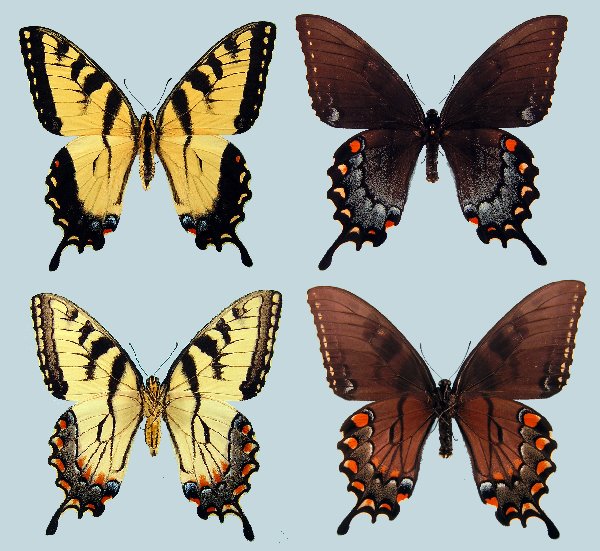Papilio glaucus glaucus (Eastern Tiger Swallowtail)

Photo Life History: Papilio glaucus glaucus
Habitat: Forest; Valley Lakes & Rivers; Urban-Suburban;
Host Plants: Prunus serotina, Salix spp.
Suitable Lab Host Plants: Salix exigua; Prunus virginiana
Caring for Live Female Butterflies: Feed females every day.
Methods of Female Oviposition: See this video. Also, the open screen cages slide show demonstrates how this is accomplished for glaucus-group females, which, can be quite uncooperative for a few days when it comes to laying eggs in captivity. It's important to set them up in a cage where there is plenty of room to fly to and from the host plant. Also, provide nectar sources for females. Clark Thompson created a successful setup for California populations of Papilio rutulus.
How to Find Eggs: Look for immatures on isolated host plants, if at all possible.
How to Hatch Eggs: Consolidate eggs into one container.
How to Find Caterpillars in the Field: For earlier instars, look on the dorsal side of the leaf. For later instars, look for swallowtail pads. Finding glaucus-group caterpillars in numbers can be difficult and sometimes requires a certain degree of patience and hard work. Always remember to look for isolated host plants.
Caterpillar setups: Open terrariums; Open Bucket, Collapsible Cages.
Larva to Pupa: Larva purges and wanders; Larva Changes Color.
Number of Broods per Year: 1-3; depending upon location
Overwintering Stage: Pupa.
Overwintering Strategies: Your Own Backyard; Refrigerator
Post-Hibernation Strategies: Expose pupae to room temperature, long-day photoperiod and high humidity (mist spray them daily.)
Avoiding Diapause Techniques: Healthy Host Plant; High Humidity; Expose larvae to 24 hours of light.
Disease Prevention: Change out host plant and remove frass every three to five days using the open terrarium technique.
Emergence: Emergence Container
Field Notes: Oddly, Illinois populations grow slowly and/or perish on Prunus virginiana and Populus tremuloides. Larvae do very well on Salix exigua. However, Texas larvae preferred Prunus virginiana over Salix.

